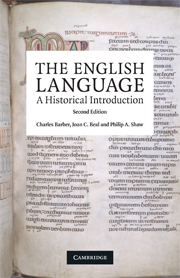Book contents
- Frontmatter
- Contents
- List of figures
- Preface to the second edition
- Preface to the first edition
- Map showing the counties of England
- 1 What is language?
- 2 The flux of language
- 3 The Indo-European languages
- 4 The Germanic languages
- 5 Old English
- 6 Norsemen and Normans
- 7 Middle English
- 8 Early Modern English
- 9 Late Modern English
- 10 English as a world language
- 11 English today and tomorrow
- Notes and suggestions for further reading
- Bibliography
- Index
10 - English as a world language
- Frontmatter
- Contents
- List of figures
- Preface to the second edition
- Preface to the first edition
- Map showing the counties of England
- 1 What is language?
- 2 The flux of language
- 3 The Indo-European languages
- 4 The Germanic languages
- 5 Old English
- 6 Norsemen and Normans
- 7 Middle English
- 8 Early Modern English
- 9 Late Modern English
- 10 English as a world language
- 11 English today and tomorrow
- Notes and suggestions for further reading
- Bibliography
- Index
Summary
Today, when English is one of the major world languages, it requires an effort of the imagination to realize that this is a relatively recent thing – that Shakespeare, for example, wrote for a speech community of only a few millions, whose language was not much valued elsewhere in Europe and was unknown to the rest of the world. Shakespeare's language was pretty-well confined to England and southern Scotland, not yet having penetrated very much into Ireland or even Wales, let alone into the world beyond. In the first place, the great expansion in the number of English speakers was due to the growth of population in England itself. At the Norman Conquest, the population of England was perhaps a million and a half. During the Middle Ages it grew to perhaps 4 or 5 million, but then was held down by recurrent plagues, and was still under 5 million in 1600. It was approaching 6 million in 1700, and 9 million in 1800. Then, with the Industrial Revolution in full flow, the population expanded rapidly to 17 million in 1850, and over 30 million by 1900.
At the same time, English penetrated more and more into the rest of the British Isles at the expense of Celtic languages, though it is only during the last two centuries that it has become the first language of most speakers in Wales, Ireland and the Scottish Highlands.
- Type
- Chapter
- Information
- The English LanguageA Historical Introduction, pp. 239 - 264Publisher: Cambridge University PressPrint publication year: 2009

